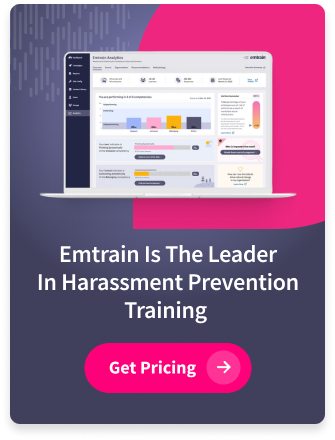The Importance of Harassment Prevention Training
Building a positive workplace culture is integral to the long-term success of any business. One way to promote such an environment is by providing harassment prevention training. Not only does this training protect employees from harassment, but it also helps create a safe and respectful work environment for everyone.
Harassment prevention training helps employees recognize what constitutes harassment, how to prevent it, and how to respond to it. This training can also help alleviate fears associated with reporting incidents of harassment.
By taking the initiative to provide harassment prevention training, employers can create a culture of respect and inclusivity, which can positively impact employee morale and productivity.
Not only is harassment prevention training beneficial for employees but is also required by law. Employers are obligated to provide a safe and healthy work environment for their employees. Companies that do not actively comply with harassment prevention laws can face serious consequences such as legal action, financial penalties, and damage to their brand name and reputation.

Source: Medium
By the end of this article, you will gain a comprehensive understanding of how to create a safe and respectful workplace for all employees.
How often do employees need workplace harassment training?
Federal and state laws require employers to provide regular harassment prevention training. However, the frequency of harassment training requirements can vary depending on the state in which the employer operates, the type of industry in which they operate, and the local laws themselves.
For example, California mandates two hours of sexual harassment prevention training every two years for supervisors and at least one hour of training to non-supervisory employees every two years.
In New York State, employers must provide annual anti-harassment prevention training to all employees.
In contrast, some states such as Maine, Delaware, Colorado, Illinois and Florida do not specify how often harassment prevention and compliance training should be provided but encourage it and emphasize that it should be “regular and ongoing.”
It is important to note that while federal law does not mandate specific requirements for harassment prevention training, the Equal Employment Opportunity Commission (EEOC) strongly recommends that employers provide regular training to their employees.
5 Important Topics to Cover in Workplace Harassment Training
Let’s dive into the five essential topics that should be covered in any comprehensive workplace training program, be it online training conducted through an LMS and webinars, or in person.
From defining the different types of harassment to discussing reporting harassment complaints to Human Resources, these topics are crucial for creating a safe and respectful workplace.
Sexual Harassment
Sexual harassment is a type of workplace harassment that includes non-consensual sexual advances, demands for sexual favors, or other verbal or physical conduct of a sexual nature.
It is a pervasive problem that can lead to a toxic work environment and can have serious legal and financial consequences for both the employer and the victim.
Harassment prevention training programs should include a thorough discussion of sexual harassment, including examples of what constitutes sexual harassment, the various types of sexual harassment, and how to prevent and report it.
Emtrain’s Preventing Workplace Harassment course covers this topic in-depth, providing employees with a comprehensive understanding of sexual harassment and the steps they can take to prevent it from occurring.
Hostile Work Environment
A hostile work environment can be incredibly damaging to both employees and employers. When an employee is subjected to discriminatory or offensive behavior that creates a toxic work environment, their productivity, mental health, and overall well-being can suffer. This can lead to high employee turnover and even legal action against the company.
That’s why any harassment prevention training program must cover this topic. It’s not just about following the law but also about creating a work culture that is respectful and inclusive for everyone.
By covering this topic, employees will better understand how to recognize and prevent hostile work environments and what steps to take if they witness or experience such behavior.
Check out our course which covers how employees can recognize the signs of a hostile work environment, the legal implications of such behavior, and how to report it.
Quid Pro Quo
Quid pro quo harassment is a type of sexual harassment that occurs when a person in a position of power or authority, such as a supervisor or manager, demands sexual favors in exchange for a job benefit or to avoid a negative consequence.
It’s important for any harassment prevention training program to cover quid pro quo harassment because it is a specific form of sexual harassment that can be difficult to recognize.
It can also happen to employees, regardless of their gender identity or sexual orientation.
If you want to learn more, check out our training courses which include a comprehensive discussion of quid pro quo harassment, including real-life examples and legal considerations. Emtrain also offers an international module.
Protected Characteristics
Protected characteristics refer to personal traits or characteristics that are protected by law from discrimination, harassment, or retaliation in the workplace. These characteristics include (but are not limited to):
-
- Age
- Race
- Gender
- Sexual orientation
- Religion
- Disability
Your harassment prevention training programs and harassment policies should include protected characteristics in order to promote inclusivity and prevent discrimination and harassment based on these characteristics.
Emtrain’s courses touch upon the importance of employees understanding how to treat all their colleagues with respect, regardless of their personal traits or characteristics.
Learners will also see how to recognize and prevent discriminatory behavior based on protected characteristics and how to create an inclusive work environment for all.
Upstander vs. Bystander
An upstander is someone who intervenes when they witness harassment or discriminatory behavior in the workplace, while a bystander is someone who observes such behavior but chooses not to intervene.
Harassment prevention training programs should include a module that covers the concept of moving from a bystander to an upstander (that is, bystander intervention) to promote a culture of respect and support in the workplace.
Our bystander training includes practical tips and techniques for speaking up when you witness harassment or discriminatory behavior and explains how small actions can make a big difference in creating a safe and respectful work environment.
By taking this course, employees will be better equipped to create a culture where everyone feels supported and valued.
Emtrain’s Workplace Harassment Course Fits the Compliance Laws of All 50 States
In this era of #metoo, there’s no sliver of a doubt that workplace harassment prevention training is a must for creating and encouraging basic human rights in the workplace, both for new employees and existing ones.
By covering the above topics, employers like you can ensure that their staff are equipped to recognize and prevent harassment and discrimination.
Emtrain’s Preventing Workplace Harassment course is a comprehensive employee training solution available on both desktop and mobile devices. It covers all of these important topics and more. It meets the compliance and employment laws of all 50 states and provides practical tips and techniques for creating a respectful and inclusive workplace.
In addition, Emtrain Intelligence is a powerful data collection and analysis tool that can be used to track employee sentiment and measure the impact of workplace harassment training.
By using Emtrain’s training and analytics tools together, employers can create a culture where everyone feels safe, supported, and valued, and take a data-driven approach to promoting a respectful and inclusive workplace.
Are you ready to get started? Book a free demo today!








